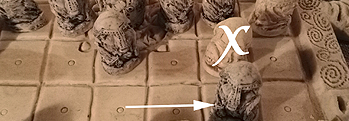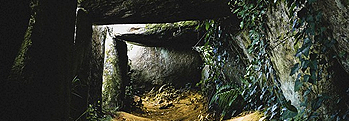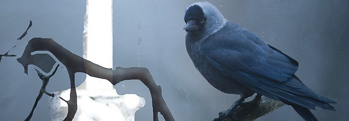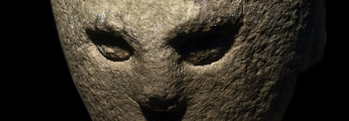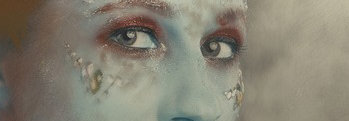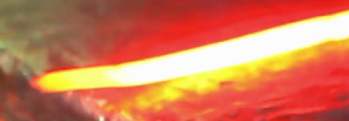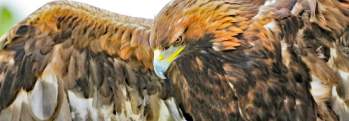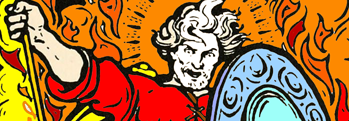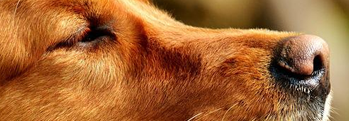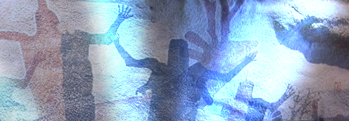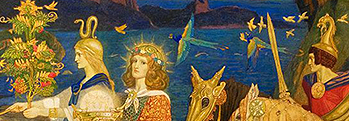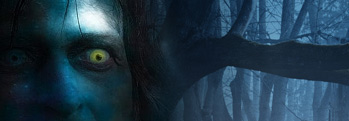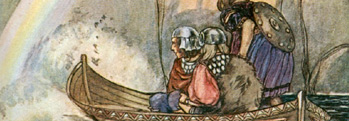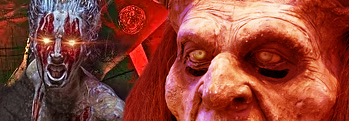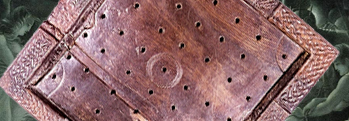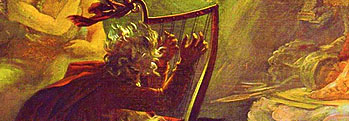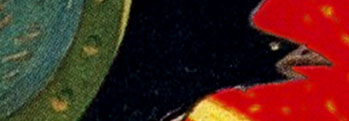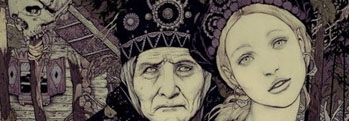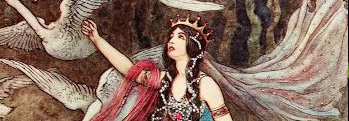The Most Powerful Druidess of Ancient Ireland
Irish and Celtic myths and legends, Irish folklore and Irish fairy tales from the Mythological Cycle
The mysteries and wisdom of Tlachtga the Druidess
 It’s a not uncommon belief that the women of Ireland in the ancient days were quiet and kept to themselves, letting the men do all the great deeds and win all the fame – but nothing could be further from the truth! From that day to this Irish women were and remain wild and fearless, willing to go to lengths as great as any man for victory, or even greater in some cases.
It’s a not uncommon belief that the women of Ireland in the ancient days were quiet and kept to themselves, letting the men do all the great deeds and win all the fame – but nothing could be further from the truth! From that day to this Irish women were and remain wild and fearless, willing to go to lengths as great as any man for victory, or even greater in some cases.
And such a woman was Tlachtga of the fiery hair, pronounced in English clock-da, she who was born of the blind Druid prince Mogh Ruith and who became the mightiest of all Druidesses. She was born and grew up on Valentia island in County Kerry in the southern part of Ireland, learning from her father all that he knew, such as the arts of growing to enormous size, how to turn men to stone, and how to raise a thunderstorm with her breath.
But she was not satisfied with this knowledge, as eldritch and miraculous as it might seem to us today! For she knew there was much more to be learned in the wide world, more even than was known by those who dwelt beneath the hill, and more than the Druids of Ireland whispered into their beards for fear the unlearned might come to harm by overhearing their secrets.
She had looked into the shimmering moon-pools nestled in the hidden bones of the earth and witnessed there wonders which had been and wonders to come, and by watching them divined much of the art and science of their operation, as one might learn a language by listening, without ever being taught a word.
When the time came that Tlachtga of the pale skin unblemished grew wise beyond the bounds of Eriú, she took her father who had been ancient before one Roman stone was laid upon another, whose life had seen nineteen kings born and buried, and went travelling to many places.
To the purple mountains of the farthest east where the sun rose they went, among the masters of bronze deserts in their caskets of gold, into the neverlit worming nightmare tunnels twisting through the earth’s bowels, to seek the wisdom of the old serpents that dwelled and dwell yet within them, and across trackless oceans they wandered.
No easy journeys would these be even today, let alone in those wild and lawless times! So Tlachtga made the roth rámach for their travels, a wonder among wonders. This was the oared wheel, a fiery flying machine which travelled with great speed across the sky. However it had been created, to gaze upon it was to be blinded and it turned night into day, it deafened all who came too close, and slew all who touched it.
It was made from sacred rowan, driven by two oxen yoked with poles of electrum, and had sides of glass. Saint Columba is said to have prophecised that before the Last Judgement, the roth rámach would once again arc across the skies of Europe, laying waste to every nation that gave disciples to dark wizards.
At last they followed the footsteps of the Tuatha Dé Danann to find the Druids Mórfheasa who was in Fálias, Easras in Goirias, Uiscias in Fionnias, and Séimhias in Muirias, the four wisest and craftiest in those ancient lost cities, but they never reached their destination, instead arriving in Jerusalem where they had divined the mightiest of mysteries was to be revealed.
There Mogh Ruith met with Simon Magus, Simon the seven-splendoured, and great was his delight in the company. He settled down to his studies and they sent Tlachtga away to travel and learn more for herself, but to their dismay, when she returned, they found she had learned more and grown more powerful than either of them!
She returned with the wise words;
She brought the moving wheel,
The perfect stone of Forcarthu she brought,
And the pillar of Cnamchaill.
Whoever sees her will become blind,
Whoever hears it will become deaf,
And anyone who tries to take a piece
From the wheel with the sharp spokes will die
Simon magus, for whom is named the sin of Simony, had a fell reputation even then before the wicked blackness of his heart was recorded in the Scriptures, and he conspired in jealousy with his three sons, who burned for Tlachtga, to do her harm.
Some versions of the tale have it that she instead had a romantic relationship with them, being just as taken with them as they were with her, hence the use of the name “Trian” to describe their encounter.
However it happened, the three of them ravished her, and she travelled back to Ireland, where she came to the hill we today call Tlachtga's Hill or the Hill of Ward in County Meath, and there she died giving birth to three sons by three different fathers. These she named Cuma, Dorb, and Muach, and gave each of the nearby plains those names as well, these were Mag Cuma, Mag nDoirb, and Mag Muaich.
As she passed away, she made a prophecy – no foreign invader would ever do harm to Ireland so long as the names of these plains were remembered and celebrated, but of course those secrets were lost and ruin followed not long afterwards.
Where she lay became a place of mystery to the pagan Druids and soothsayers of ancient Ireland, and every Samhain, or Hallowe’en, “the Fire of Tlachtgha was instituted, at which it was their custom to assemble on the eve of Samhain to offer sacrifice to all the gods... it was of obligation under penalty of fine to quench the fires of Ireland on that night, and the men of Ireland were forbidden to kindle fires except from that fire... the priests, augurs and druids of Ireland [would] assemble upon the eve of All Saints, in order to consume the sacrifices that were offered to their pagan gods.”
From her sons sprang the line of the Kings of Mide, which means the Middle Kingdom, or Meath as it is known today.
Tlachtga, proud and princely hill, has seen the passing of many a stern king,
since long ago seemly Tlachtga possessed it, daughter of the famous slave of kingly Roth.
Mug Roith was son of Fergus Fáil, son of royal and worshipful Ross;
Cacht daughter of Cathmann skilled in feats was his own mother, fresh of hue.
Roth son of Rigoll fostered him, therefore was he Roth's chosen Slave:
his two sons were Buan and Corb, whose noble chant brought the people luck.
The mother of those goodly sons was Derdraigen, strong, fierce, and fell:
she was mother too of Cairpre, as my gentle bardic art certifies
Daughter of Mug, master of thousands, was choice Tlachtga—not chill was her bosom:
with her giant father dear went she to noble Simon sechtmisid.
Three sons had Simon, who dwelt at ease; gigantic was their league of hell:
Nero, Carpent, and Uetir, they were a mighty race, mortal in conflict.
All the sons together gave their love to Tlachtga secretly, and quickened her womb,
in truth, with offspring like in build and bulk.
Tlachtga—no weakling was she—was one of three, with the beloved giant Slave and with Simon sechtmisid, who made the red well-finished Wheel.
She carried with her the fragment, I wis, that the cunningly-made Wheel left behind it,
the perfect Stone at feeble Forcarthain and the Pillar at Cnamchaill.
Blind is each that once sees it, deaf is each that hears it:
dead is he that aught touches of the rough-jagged dreadful Wheel.
When the woman came westward she bore three sons of great beauty:
she died at their birth, the bright brisk lady: a strange tale—let us hear it and hide it not!
The names of her sons (no meagre utterance) were Muach and Cumma and darling Doirb:
'tis for the men of Torach, that claimed them for its own, to hear their names—and mark ye them!
As long as the names of her sons shall be held in honour throughout Banba
(this is a true saying to spread abroad) there comes no ruin to her men.
The hill where a grave was built for the lady of the chilly lands,
above every title given by lucky poet it bears the style of silent Tlachtga.
The Hill of Tlachtga can be found on the map below!
More Stories from the Mythological Cycle
We are delighted to be able to present to you the rules of Fidchell, the Irish game of kings! This game can be purchased, but it's easy to get started and try it out for yourself. All you need is a 7 x 7 board, which can be squares or pins marked out - even on paper - 16 white or attacker pieces, a king piece, and 8 darker-coloured defender pie ... [more]
Times were hard in Ireland not so long ago, and harder yet they were before that – many’s the family was cast out of their houses for being unable to pay their rent! One such was poor Finian O’Toole, the kindly father of nine children who found himself evicted by the cruel English landlord in the parish of Kilmoe. Now it was th ... [more]
There is a tale, one of the oldest stories among the many very ancient stories of Ireland, of a man who returned to life as a man thousands of years after he first walked the earth. His legend was found in an eleventh century manuscript called Lebor na hUidre, which means The Book of Dun Cow, and it was written there by the followers of an early ... [more]
It’s a not uncommon belief that the women of Ireland in the ancient days were quiet and kept to themselves, letting the men do all the great deeds and win all the fame – but nothing could be further from the truth! From that day to this Irish women were and remain wild and fearless, willing to go to lengths as great as any man for victo ... [more]
Of great renown are the feats and deeds of the ancient heroes of Ireland, and still to this day they echo through our legends where such tales are told. But of scarce less fame were the weapons they bore, implements of glory and terror, bound to ancient spirits and clasping lightning within their shimmering length, wielded with scarcely imaginable ... [more]
The Tuatha De Danans By the force of potent spells and wicked magic, And conjurations horrible to hear, Could set the ministers of hell at work, And raise a slaughtered army from the earth, And make them live, and breathe, and fight again. So it was written in Keating's General History of Ireland, considered by many to be the definitive ... [more]
Her name was Clíona or Clíodhna and she was one of the most beautiful women of the Tuatha Dé Danann, that vanished sorcerous race whose legends echo still from one end of Ireland to the other. Some even say she was the most beautiful woman in the world, and she was worshipped as a goddess by the pagans of Ireland who followed t ... [more]
Many are the tales told of Lugh, the mightiest king of that ancient and mystical sorcerer race of Ireland, the Tuatha Dé Danann, but only one is told of his death. Now Lugh, lord of many warriors, had four wives, which back in those days wasn’t too unusual, and their names were Echtach, daughter of white-toothed Dagda, Englec, Ná ... [more]
Just as happens today, people in ancient Ireland had legal disputes and complaints they would bring before their courts, and the judge or king would try to make sense of what had happened and hand down a fair decision. But also just as happens today, there were situations where it was one person’s word against another, or there wasn’ ... [more]
The old stories of Ireland, some of the oldest in the world, tell of great ancients – almost immortals! – whose span of life stretched many thousands of years. Legends tell of their spirits passing from one body to the next, or upon occasion, staying in the one body for millennia, watching the tides of man and beast come and go. Such ... [more]
One of the chiefest and most powerful kings among the mystical Tuatha Dé Dannan was the one called Dagda, or Dagda Mór, which means “of shining skills”. He had other names too, such as Eochu the horseman, Ruad Rofhessa, lord of great knowledge, Dáire the fertile one and Aed, he of the fiery temper. Others yet called ... [more]
The Irish Brehon law codes are said to be the earliest fully developed legal system in Europe, but long before the Brehons were laid down there were earlier laws and all were subject to them, from the lowest to the highest! Women could hold their own property, were not themselves considered property, and could seek an education and improve their ... [more]
No tale of ancient Ireland could be complete without mentioning the Fomorians, dreaded foes of the Tuatha Dé Danann and all who came to conquer Ireland. The meaning of their name is debated even today, although most agree that the first part, fó, means “from below” or “nether” and the latter part means “t ... [more]
Many of the oldest records of Irish mythology and legend, which you might truthfully say are a history of prehistory, tell that the first people to arrive in Ireland were led by the lady Cessair when she fled to this land to escape the coming flood. The idols which had whispered through veils of midnight smoke that Ireland was a land untouched by p ... [more]
Throughout the old stories of Ireland are scattered mentions, and sometimes even descriptions, of some of the spells and rites used by both the Tuatha Dé Danann and those who came after them, the Gaels or Milesians, as they are sometimes known. Tales of these wondrous and mysterious feats of sorcerous skill may seem strange to us, but to the ... [more]
It was a warm and balmy summer's night, heavy with the fragrances of heather and honeysuckle, when Aengus, son of Dagda, awoke to find a beautiful young woman approaching him where he had slept. He was immediately taken with her grace and elegance, and his heart yearned for her, but when he tried to speak, she vanished! He stayed in his bed ... [more]
The river Barrow, like many rivers in Ireland, was given its name in ancient times. Few now know it once had another and very different name however, for it was when Dian Cécht walked the world, the healer of the Tuatha De Danann, that this river was first named! Dian Cécht, whose name meant swift power or swift potion, depending o ... [more]
A thousand years before the Olympic games were founded, the Tuatha De Dannan had arrived in Ireland and defeated the Fir Bolg, establishing their place on the Emerald Isle. The mighty queen Tailtiu had married Eochaid mac Eirc of the Fir Bolg, but he was killed during the invasion of Ireland by the Tuatha, so the leader of the invaders took her for ... [more]
In ancient times the Gaels would hold great festivals at different seasons of the year, such as the Tailteann Games, Tlachtga, Raigne and Lughnasadh, and it was at the beginning of August, every three years, that the festival of Carmun would be held during the festival of Lugh. Mighty were the celebrations held, with the racing of horses and the ... [more]
Long ago it was the time of the Tuatha De Danann in Ireland, and they were troubled by strife from beyond the Emerald Isle and within it. One of their mightiest warriors whose name was Lugh of the Long Hand heard that their demonic enemies from the sea, the Fomorians, had landed at Eas Dara, so he hopped up on Aonbharr, a horse which could gallop a ... [more]
Some of the most ancient Irish myths and legends tell of the Bocanachs and the Bananachs, known to the people of Ireland as fierce spirits of the air that were drawn to scenes of battle and bloodshed. Whenever armies gathered to test their might, the sky overhead would be filled with shrieking demons dancing to the sounds of swords clashing and blo ... [more]
Woven through many Irish stories, myths and legends is the ancient game of Fidchell, which means “wisdom of the wood”. It's said that it was invented by none other than Lugh of the Tuatha De Dannan, and predates chess by many centuries. Fidchell held a central role in the celebrations of Lugh, and at Samhain festivities as well, ... [more]
Well known is the ancient tale of the Children of Lir, and how two of the three of Bodb Dearg's daughters by Oilell of Aran married Lir to keep the peace in Ireland, between the rival chieftains of the Tuatha De Dannan. But less well known perhaps is the story of the daughter of the Bodb and one of her admirers, Cliach the Harpist. Cliach pl ... [more]
After the second battle of Moy Tura, Nuada the High King of the Tuatha De Danann was grievously injured, and as it was the law among their people that a king must be whole of body, Dagda Mór took his place. Mighty Dagda, of whom the ballads are sung, he was called the father of the Tuatha, the lord of knowledge, the many-skilled, th ... [more]
It is in the nature of fairytales and legends passed down from generation to generation that they might sometimes change and shift to fit the lives of the people of the time, and the more mysterious the figure the more legends accrue to it! And so it is with Donn of the Dead, king of the dead at the red tower of the dead, whose three sons cried &ld ... [more]
It was at the dawning of the world when the fair folk walked in broad daylight as bold as you and I, before the coming of the Milesians with their bitter iron blades and earthen ways, it was the time when magic was wrought and druidry had power, when heroes gave battle to gods and the titanic children of Seth still troubled the dreams of Heaven, it ... [more]
The raven has long been an omen of ill-tidings around the world, bearer of bad news and warnings, but in Ireland it was known once as a servant of the fairy Morrigan, or the raven was herself in person! She it was whose name meant the Great or Ghost Queen, from the old words for fear and greatness. Some will tell you earnestly that she was a god ... [more]
Long ago, in the time of the Tuatha Dé Dannan, one of their number became the high king of all Ireland, and his name was Eochaid Ollathair. He was a powerful magician of that sorcerous race, and by his workings he could change the weather and ensure the harvest was plentiful, as well as many other things. His wealth was vast and he was mu ... [more]
It was in the time of legends and heroes, when the Tuatha Dé Dannan had determined to go into their deep halls beneath the hills and mountains of Éireann the green, that the Dagda mór had fallen at the second battle of Moy Tura. With his slaying a new leader had to be elected and that was decided by the Tuatha to be the Red Cro ... [more]
And so it was when dragons still flew and champions walked the earth that the men of the Fir Bolg had lordship over all of Ireland. They had left Ireland centuries before due to the violence and heavy tribute demanded by the Fomorians, travelling far and wide until they came to the distant land of Greece. Although they made agreement and treaty ... [more]




